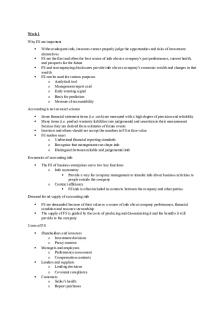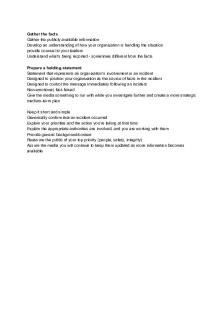Sub Assignment #2-Thesis:Preview Statement And Notes PDF

| Title | Sub Assignment #2-Thesis:Preview Statement And Notes |
|---|---|
| Author | Sandra Cross |
| Course | English Composition |
| Institution | University of Alabama |
| Pages | 25 |
| File Size | 348.4 KB |
| File Type | |
| Total Downloads | 43 |
| Total Views | 140 |
Summary
Taught by Mr. Beall. Thesis preview statement and notes on "The Cathedral" by Raymond Carver. ...
Description
Mr. Beall English Composition 102 12 July 2016 Thesis and Preview Statement
Preview Statement: Despite the feelings of inadequacy from the narrator in "Cathedral" written by Raymond Carver, he is able to break free from his mental "blindness" by viewing the world through Robert’s perspective on life.
Working Thesis Statement: However, beforehand, the narrator's unhealthy jealousy, marital complications, self-alienation, and his alcoholism are all causes towards his initial mental “blindness”. These four factors also directly associate with how the narrator's "blindness" differentiates from Robert's physical, visual blindness.
Preview and Working Thesis Together: Despite the feelings of inadequacy displayed by the narrator in "Cathedral" written by Raymond Carver, he is able to break free from his mental "blindness" by viewing the world through Robert’s perspective on life. However, beforehand, the narrator’s unhealthy jealousy, marital complications, self-alienation, and his alcoholism are all causes towards his initial mental “blindness”. These four factors are directly associated with how the narrator's "blindness" differentiates from Robert’s physical, visual blindness.
1
Bibliography Notecard
1.
Messer, H. Collin. “Fleeing the Wasteland of Alcoholism: Alienation, Recovery, and Bibliography Notecard HopeNotecard In Raymond Carver’s Cathedral.” (2012): Studies In Short Fiction 37.1 2. Bibliography 3. Facknitz, Mark 43-58. A. R. “‘The Calm’, ‘A Small, Good Thing’, And2016. ‘Cathedral’: (2012): Academic Search Web. 11 July Clark, Robert C. “Keeping The Reader InPremier. The House: American Minimalism, Raymond Carver And The Rediscovery Of Human Worth.” Studies In Short Literary Impressionism, And Raymond Carver’s “Cathedral..” Journal Of Alcoholism/Direct Quote 1. Bibliography Notecard 4. Fiction 23.3the (1986): 287. between AcademicRaymond Search Premier. Web. 13 July 2016. This article shows relevance Carter’s narrator in “Cathedral” Modern Literature 36.1 (2012): 104-118. Academic Search Premier. Web. 13 Gearhart, Michael Wm. “Breaking The Ties That Bind: Inarticulation In The Fiction and alcoholism, alienation, recovery, and hope. I can use this journal article to tie July 2016. “…Carver weaves into “Cathedral” a narrative of alcoholism, from addiction and Raymond In Short Fiction 26.4 (1989): 439-446. AlcoholOf Addiction InCarver.” Carver’sStudies Character/Paraphrase 1. This journal article provides information about the narrator his own the narrator’s alcoholism, alienation, recovery, or hope having to it being the cause of alienation, to bitter self-awareness and then, sometimes, a legitimate hope of Academic Search Premier. Web. 13 July 2016. “blindness” apart from Robert’s blindness by explaining the narrator’s shift in his own This article“blindness”. describes the narrator’s “blindness”, in “Cathedral” written by Raymond recovery.” (lines 18-19) perspective. I can use this for background or as evidence that the narrator has Carver, and how it was being caused by his initial mindset towards the outside world. This journal Raymond article is about Raymond Carver’s works in whole and each of his Several works display alcohol addiction in ahow way that creates factors of towards his Carver’s “blindness” that are different from Robert’s visual I can use this article as further evidence for what the narrator’s “blindness” is character’s, throughout various stories, arethe almost alwayswho blue-collar men with the self-alienation and discomfort within character’s are experiencing blindness. caused by and how it is different from Robert’s visual blindness. marital, alcoholism, and financial issues. I can use this source as an underlying addiction. factor that the narrator within “Cathedral” written by Carver is blinded by all of the factor’s that most of Carver’s character’s share.
2
How Cathedral Differs From Previous Works/Paraphrase
1.
My Thought/Alcoholism Tied to Cathedral
1.
“Cathedral”, one of Carver’s short story, is considered to be set apart from his earlier works because he gives the characters within “Cathedral” a chance towards recovery and finding hope again. Alcohol is made out to be the narrator’s necessity in order to communicate normally or more affectionately with the people in his life.
3
My Idea/Cause of Alienation Within the Narrator in Cathedral
1.
My Thought/ Alcoholism’s Effects on the Narrator
1.
Because of the narrator’s social reliance on alcohol, this advertises that alcohol is a radical influence towards the narrator’s self-alienation. Alcoholism isn’t the only thing causing self-alienation in the narrator but it is one of the main sources of the narrator’s mental “blindness”.
4
My Idea/ Alienation’s Effects on the Narrator
1.
My Idea/ Alienation’s Effect on Narrator 1. The narrator’s self-alienation combined with alcoholism is a contributing reason why the narrator is having marital issues between him and his wife. The narrator’s self-alienation is directly associated with his mental “blindness” and his view of the world as well as the people in his life.
5
Fleeing the Wasteland/Summary
1
The characters within Carte’s short stories live through alcoholism, self-alienation, and Effects from lack of self-awareness “blindness” causing them to be oblivious towards, what could be, what sets them free1. Carver uses the narrator’s alcoholic characteristic to lay the foundation of the idea that from their own minds. most alcoholics are “blind” or “unself-conscious” of their addiction and how it affects themselves as well as other’s around them.
6
Narrator’s release from blindness/summary The narrator lacks insight on his own issues or “blindness” and is shown by the blind2. man to “see” what he could not see in himself. The narrator’s jealousy/direct quote Clearly he is jealous, and so emphasizes the eroticism in the blind man’s touch.
7
2.
Lack of Emotion in Narrator/Paraphrase The narrator speaks of his wife’s past suicidal attempt as if it had no significance and2. seems to think the attempt, which ended with her throwing up the gin she downed, is equal to his alcoholism, which has him staying up late drunk in front of the TV. My Thoughts/The Narrators Blindness His “blindness” spread into all categories including alcoholism, alienation, jealousy, 2. and the distance he holds from others.
8
My Thoughts/Narrators Blindness 2. The narrator doesn’t “see” that he pushes people away until his wife reminds him that he doesn’t have any friends after he tells her he doesn’t have any blind friends. My Thoughts/Narrator’s Blindness He doesn’t want to be face-to-face with his issues, so he simply ignored them and2. drinks or smokes them away.
9
Blind Man’s Influence on Narrator/Paraphrase 2. Robert’s influence on the narrator is significant seeing that Robert is blind and a blind man is the one to enlighten the narrator. Irony Present in “Cathedral”/My Thoughts “Cathedral” displays irony when the narrator is freed from his mental “blindness” by2. physically, visual blind man.
10
Loneliness Within Narrator/Direct Quote 2. “He is numb and isolated, a modern man for whom integration with the human rce would be so difficult that it is futile.” (294) Understanding Within Narrator/Direct Quote “…underdtanding (others) comes as a result of an unearned and unexpected gift, a 2. kind of grace constituted in human contact.” (295)
11
3.
22.
12
23.
24.
13
25.
26.
14
27.
28.
15
29.
30.
16
35.
36.
17
37.
38.
18
39.
40.
19
41.
42.
20
23.
24.
13
25.
26.
14
27.
28.
15...
Similar Free PDFs

Sub Q injections - Exam notes
- 3 Pages

Sub Procesos
- 14 Pages

Nucleo sub lab report
- 3 Pages

Sub espacios vectoriales
- 6 Pages
Popular Institutions
- Tinajero National High School - Annex
- Politeknik Caltex Riau
- Yokohama City University
- SGT University
- University of Al-Qadisiyah
- Divine Word College of Vigan
- Techniek College Rotterdam
- Universidade de Santiago
- Universiti Teknologi MARA Cawangan Johor Kampus Pasir Gudang
- Poltekkes Kemenkes Yogyakarta
- Baguio City National High School
- Colegio san marcos
- preparatoria uno
- Centro de Bachillerato Tecnológico Industrial y de Servicios No. 107
- Dalian Maritime University
- Quang Trung Secondary School
- Colegio Tecnológico en Informática
- Corporación Regional de Educación Superior
- Grupo CEDVA
- Dar Al Uloom University
- Centro de Estudios Preuniversitarios de la Universidad Nacional de Ingeniería
- 上智大学
- Aakash International School, Nuna Majara
- San Felipe Neri Catholic School
- Kang Chiao International School - New Taipei City
- Misamis Occidental National High School
- Institución Educativa Escuela Normal Juan Ladrilleros
- Kolehiyo ng Pantukan
- Batanes State College
- Instituto Continental
- Sekolah Menengah Kejuruan Kesehatan Kaltara (Tarakan)
- Colegio de La Inmaculada Concepcion - Cebu











